2018
Flight Simulators by Techworks
The 2018 Tony Sale Award (TSA) for computer conservation was won by a project to restore three generations of flight simulators.
The Center for Technology and Innovation (Techworks!) in Binghamton, New York, USA, has brought back to life a Second World War analogue flight simulator, a 1960s solid-state hardware version and a digital simulator from the 1980s. The public has been able to experience each of the three ‘Pilot Makers’ to grasp the pace of innovation and development of simulation technology.
Prof. Martin-Campbell-Kelly, chair of the Computer Conservation Society TSA judging panel, congratulated the winners – “In reproducing novel computing applications which the public can experience first-hand, the Techworks! team gives us an unforgettable impression of the early days of virtual worlds. Excellent research, skilled implementation and an impactful result make this a superb example of the power and relevance of computer conservation, something that I know would have met with the late Tony Sale’s enthusiasm and approval.”
The Techworks! project was inspired by the simulation industries in its local area of Binghamton, widely regarded as the birthplace of flight simulation. The restoration of the three simulators has presented very different challenges requiring contrasting skillsets.
A commitment to continuing to improve public access to the simulators aims to ensure that the value of computer conservation and the early developments in our digital world can be widely appreciated.
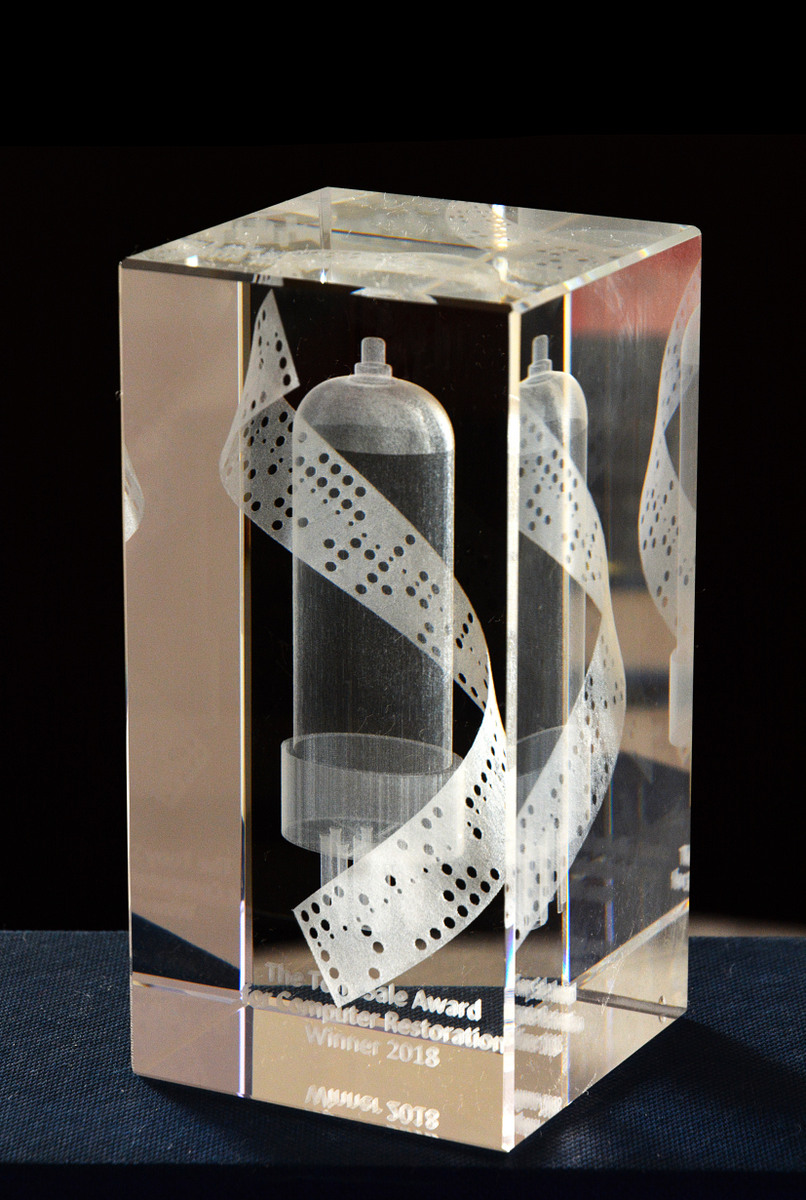
|
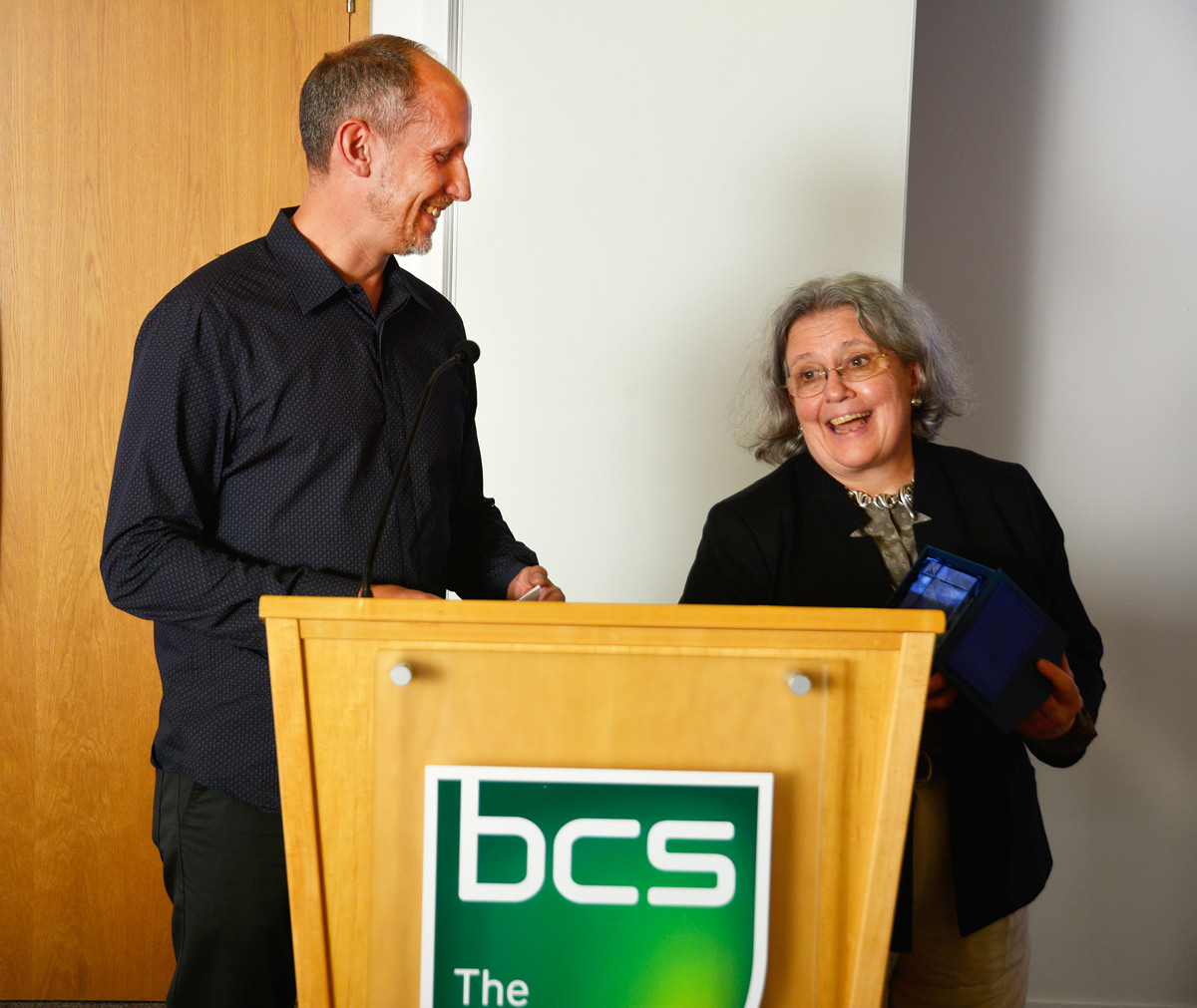
|

|
| The 2018 Sale award trophy | Susan Sherwood (Director Techworks!) receives the award from Nigel Sale, Tony Sale’s son. | The earliest, electro-mechanical flight simulator |
Other short-listed entries for the 2018 Tony Sale Award included –
- Bob Supnik and SIMH Computer History Simulation Project – software which has been used to simulate numerous historical computers
- An accurate physical reconstruction by the Museo de Informática ICATEC in Buenos Aires of CLEMENTINA, a Ferranti Mercury and the first scientific computer in Argentina.
- Electrologica Foundation: The EL-X8 at the Rijksmuseum Boerhaave, The Netherlands honouring Dutch computer pioneer Edsger Dijkstra,
- The Virtual Colossus Project, by Martin Gillow – web-based simulation of Colossus and Lorenz 1940s cypher-making and cypher breaking
2016
ENIAC Arithmetic Unit Replica by the Heinz-Nixdorf MuseumsForum
The 2016 Tony Sale Award for computer conservation was won by the Heinz-Nixdorf MuseumsForum for its evocative and educational reconstruction showing how ENIAC, one of the first electronic computers, was programmed.
ENIAC was programmed by plugging wires and turning knobs, a physical skillset quite different from those deployed today. The reconstruction of part of the huge 1946 American computer has the look and feel of the original, but has been simplified to make it readily understood and even programmable by non-specialists.
Chair of the judging panel, Professor Martin Campbell-Kelly said, “The HNF reconstruction captured the essence of the landmark ENIAC computer. The panel was particularly impressed at the thought and planning that went into making the reconstruction accessible to non-specialist audiences. Then the execution of the ideas produced an artefact that is robust and ideal for a hands-on museum display to demonstrate the physicality of early computer programming. Modern audiences are bound to be surprised and captivated by the reconstruction.”
The inspiration for the reconstruction was the HNF’s Ada Lovelace bicentenary celebration - the ENIAC was originally mostly programmed by women. Operating six days a week in the museum, the reconstructed ENIAC accumulator (a ‘register’ in modern terminology) is safe and robust enough to be operated unsupervised by visitors.
Campbell-Kelly concluded, “The judging panel has been especially pleased at the sheer variety of entries we are receiving for the Tony Sale Award for computer conservation. The ENIAC reconstruction is quite different to our previous winners: Dr David Link's computer art installation, LoveLetters; the IBM 1401 experience by the Computer History Museum; and the virtual reconstruction of the German 1930's Z1 mechanical computer. With such diversity and global interest, the Tony Sale Award is providing a great benchmark for the developing science and art of computer conservation.”
Other entries shortlisted for the 2016 award included
- A restoration of a 1972 PDP-12 computer by the Rhode Island Computer Museum and,
- From the Jim Austin Collection in York, England, the conservation of a 1980s IBM 3084 mainframe computer and a Cadlink computer aided design machine.
- The restoration of a 1960s computer peripheral, an IBM 1403-N1 printer at TechWorks! VIntage IBM Computing Center, Binghamton, NY, USA. This outstanding project was nominated runner-up in a closely fought competition.
The award was presented at the London CCS meeting on Thursday 17th November and was followed by a fascinating presentation from Johannes Blobel who designed the exhibit together with Rainer Glaschick from Paderborn who was sadly unable to be present.
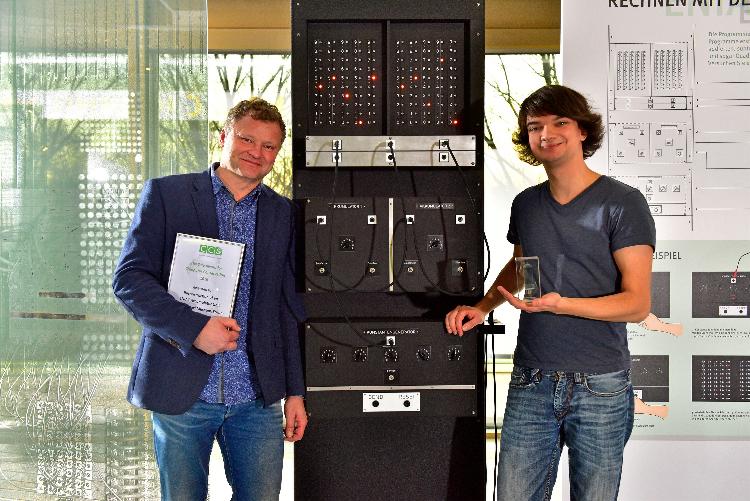
|
| Dr Jochen Viehoff (Director Heinz Nixdorf MuseumsForum) and Johannes Blobel and the ENIAC reconstruction at HNF. (Photo by Jan Braun/HNF.) |
A video of the reconscructed ENIAC panel being demonstrated can be seen at youtu.be/QUQWH1jzWoI.
2014
The 2014 Tony Sale Award for computer conservation was jointly awarded to two outstanding and contrasting entries representing computing in the 1930s and the late 1950s.
The winners are the IBM 1401 Experience, a restoration of one of the most significant machines in computer history by the Computer History Museum in California, and Z1 Architecture and Algorithms, a virtual reconstruction of the 1930’s Konrad Zuse mechanical computer, by the Free University of Berlin.
IBM 1401 Experience by the Computer History Museum
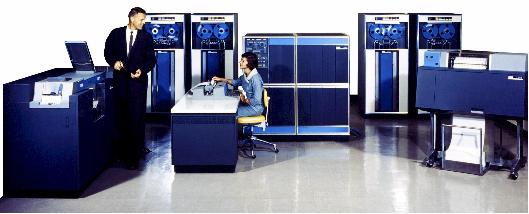
|
The IBM 1401 Demo Lab is a classic reconstruction of a 50-year old commercial computer. It marked the transition of IBM as a supplier of accounting machines to it becoming the dominant supplier of the mainframe era. Announced in 1959, the IBM 1401's success took everyone by surprise. The company had expected to sell or lease about 1,000, but went on to deliver 15,000 and by the mid-1960s they amounted to half of the computers in the world. Its high-speed chain printer was a key to its success -- punched card machines were eagerly traded in for the IBM 1401 and business computing took a huge stride forward.
In a project involving 20 volunteers over ten years, two 1401s have been restored at the Computer History Museum in California. The computers and the ancillary equipment including the famous 1403 chain printer are on permanent display and the working system is demonstrated twice a week. See www.computerhistory.org/atchm/restoring-the-ibm-1401
The judging panel said: “The IBM 1401 Demo Lab is a flawless restoration of a machine that signalled a turning point in the computer industry and the use of computers in business.”
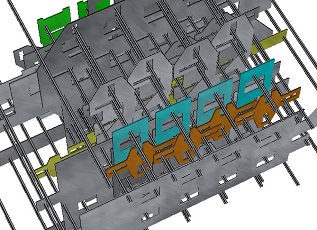
|
Z1 Architecture and Algorithms by Raúl Rojas at the Frei Universität, Berlin
Z1 Architecture and Algorithms, the other joint-winner, is a virtual reconstruction of one of the world's earliest computers, the Z1. Originally built in 1936-38, the Z1 was destroyed in a bombing raid in 1943. In the 1980s and then in his 70s, Konrad Zuse embarked on a reconstruction of the Z1 which is now a remarkable but static exhibit at the Technology Museum in Berlin. However, with 30,000 parts the reconstruction of the mechanical computer was unlikely to be robust or reliable enough for regular operation, so a team led by Professor Raúl Rojas began a virtual reconstruction.
Through the meticulous research of Professor Rojas, a team of his students was able to construct a 3D visual simulation of the arithmetic unit for deployment on the web. In addition, hundreds of high resolution photos of the Z1 enable web users to explore the machine from any angle at very high resolution. See zuse-z1.zib.de for the virtual reconstruction.
The judging panel said “Z1 Architecture and Algorithms is a remarkable vision of how such complex artefacts might be delivered to a worldwide audience. It is a project that will undoubtedly give museum curators pause for thought.”
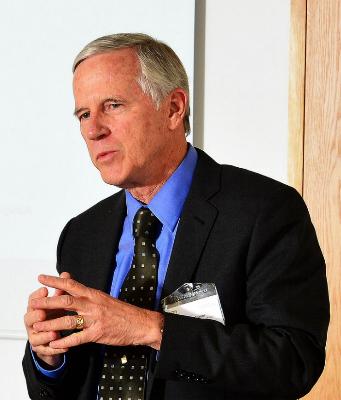
|
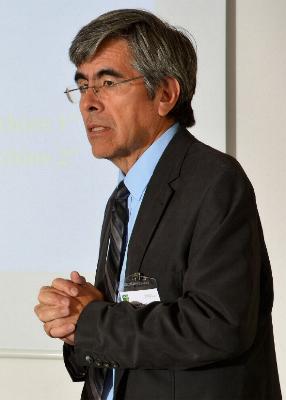
|
|
Robert Garner representing the IBM 1401 team |
Prof. Raúl Rojas |
In announcing the 2014 winners, Martin Campbell-Kelly, computer historian and head of the judging panel, said : “The eight excellent entries for the 2014 Tony Sale Award from four different countries clearly demonstrates how computer conservation is flourishing more than 20 years after Tony Sale embarked on his pioneering and awe-inspiring reconstruction of a Colossus Mk II, a world-famous exhibit at The National Museum of Computing on Bletchley Park.”
Rachel Burnett, Chair of the CCS, said “The late Tony Sale would have been delighted with the entries that we have had in the year of the silver jubilee of our Society that he co-founded with Doron Swade.
“The computer conservation movement is dynamic and growing apace. Through the Tony Sale Award, we salute the computing pioneers of the past and the dedication of those today who breathe vibrant life into our incredible computing heritage.”
The remaining six entries were
- The Analogue Computing Museum collection in Schwalbach, Germany. www.analogmuseum.org
- The Jim Austin Computer Collection in York, England. www.computermuseum.org.uk
- The restoration of 1970s DEC PDP computers at The Rhode Island Computer Museum (RICM), Rhode Island, USA. www.ricomputermuseum.org
- The PRS 4, a restoration of a 1973 Polish micro-computer at the Muzem Historii Komputerow i Informatyki (MHKI) in Katowice, Poland. www.muzeumkomputerow.edu.pl
- The Technikum29 Computer History Museum collection in Frankfurt am Main, Germany. www.technikum29.de
- The WITCH-E project, a trans-Atlantic educational project, by David Anders. www.elinux.org/WITCH
2012
“Loveletters” Installation by David Link
The inaugural Tony Sale Award was won by Dr David Link for his computer art installation LoveLetters, a replica of a 1951 computer with reconstructed software that generates texts to express and arouse emotions.
Dr Link's LoveLetters reconstructs the 1951 Ferranti Mark 1 computer which executes the original recovered software by Prof Christopher Strachey, a philosopher and pioneer in programming, to generate automated "love letters". Visitors can interact with a functional replica of the Ferranti Mark 1 containing many of its original components, to gain an authentic impression of the look-and-feel of the original computer.
The Tony Sale Award, managed by the Computer Conservation Society and sponsored by Google was set up to recognise achievements in the growing area of computer conservation. Tony Sale, perhaps best known for leading the team that rebuilt the Colossus computer, helped establish the Computer Conservation Society, co-founded The National Museum of Computing and was a key figure in starting the campaign to save Bletchley Park in the early 1990s.
Rachel Burnett, who chaired the panel of judges in 2012 and is Chair of the Computer Conservation Society, said: "We were delighted by the quality and variety of the entries for the 2012 Tony Sale Award. The nominations clearly developed the idea of computer archaeology and their exciting diversity made the task of judging very challenging! "
The winning entry by Dr David Link was both a brilliant technical construction and a work of art. Its fusion of art, engineering and history celebrates one of the first artistic applications of the computer in a visually attractive way. The wide cultural appeal, originality and touch of genius of this entry set it apart for us and has given us an inspiring first winner of the Tony Sale Award."
Dr Link said: "I feel extremely honoured to officially step into the footsteps of a Colossus as bright and wonderful as Tony Sale. I am most grateful for the recognition of my work and I thank the members of the Computer Conservation Society, without whom the project, and the fun connected with it, would not have been possible."
Peter Barron, Director of External Relations at Google, which sponsored the Award, said: "It's important that we preserve not only the memories, but also the machines, if we are truly to understand and learn from our computing heritage. Google is delighted to support this award to recognise the unsung heroes who invest their time and skill to bring computers of the past back to life. Congratulations to all who took part."
Other nominations for the 2012 Tony Sale Award were:
- DEC PDP1 restoration led by Dag Spicer of the Computer History Museum in California, USA: a computer restoration project of Digital Equipment Corporation (DEC)’s first computer.
- Time-Line Computer Archive by Michael Armstrong & Sandra Hodson, in Wigton, West Cumbria, UK: aiming to collect, restore and exhibit all types of early computers and electronics.
- Z3 reconstruction in Hunsfeld, Germany, by Professor Doctor Raül Rojas: a reconstruction and simulation of Konrad Zuse’s Z3 Computer, originally built in Berlin between 1938-1941 and destroyed during World War II.